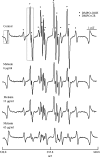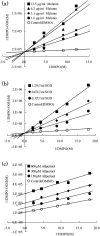Scavenging or quenching effect of melanin on superoxide anion and singlet oxygen
- PMID: 20490317
- PMCID: PMC2872227
- DOI: 10.3164/jcbn.09-84
Scavenging or quenching effect of melanin on superoxide anion and singlet oxygen
Erratum in
-
Erratum.J Clin Biochem Nutr. 2010 Nov;47(3):267. Epub 2010 Oct 29. J Clin Biochem Nutr. 2010. PMID: 21103037 Free PMC article.
Abstract
Although photoprotective properties of skin melanin have been well documented, a few studies on the effect of melanin on reactive oxygen species (ROS) generated by ultraviolet (UV) irradiation have been reported. To study the interaction of melanin with ROS, scavenging or quenching effect of melanin on O(2) (*-) and (1)O(2) was examined by electron spin resonance (ESR)-spin trapping methods and a spectrophotometric method, respectively. Melanin potently interacted with O(2) (*-) generated in a hypoxanthine (HPX)-xanthine oxidase (XOD) reaction, and with (1)O(2) generated from a peroxidase, H(2)O(2), and halide system. In the HPX-XOD reaction, it was proved that melanin doses not interfere with the enzyme reaction. It is confirmed that one of the mechanisms by which melanin protects UV-induced skin damage is likely scavenging or quenching activity against ROS such as O(2) (*-) and (1)O(2).
Keywords: antioxidant; melanin; reactive oxygen species.
Figures




References
-
- Brash D.E., Ziegler A., Jonason A.S., Simon J.A., Kunala S., Leffell D.J. Sunlight and sunburn in human skin cancer: p53, apoptosis, and tumor promotion. J. Invest. Dermatol. Symp. Proc. 1996;1:136–142. - PubMed
-
- Wikonkal N.M., Brash D.E. Ultraviolet radiation signature mutations in photocarcinogenseis. J. Invest. Dermatol. Symp. Proc. 1996;4:6–10.
-
- Brenner D.J., Doll R., Goodhead D.T., Hall E.J., Land C.E., Little J.B., Lubin J.H., Preston D.L., Preston R.J., Puskin J.S., Ron E., Sachs R.K., Samet J. M., Setlow R.B., Zaider M. Cancer risks attributable to low does of ionizing radiation: assessing what really know. Proc. Natl. Acad. Sci. U.S.A. 2003;100:13761–13766. - PMC - PubMed
LinkOut - more resources
Full Text Sources
Other Literature Sources
Miscellaneous

